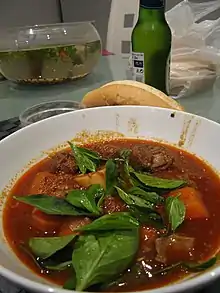 | |
| Alternative names | Kha |
|---|---|
| Type | Stew |
| Place of origin | Vietnam |
| Region or state | South East Asia |
| Associated cuisine | Vietnamese and Cambodian cuisine |
| Main ingredients | Sugar, water or coconut juice, fish sauce, soy sauce, and aromatics |
Kho (chữ Nôm: 𤇌 or 庫, meaning "to braise", "to stew", or "to simmer"[1]) or kha (Khmer: ខ) is a cooking technique in Vietnamese and Cambodian cuisine,[2][3] where a protein source such as fish, shrimp, poultry, pork, beef, or fried tofu is simmered on low or medium heat in a mixture of sugar, and water or a water substitute such as young coconut juice and seasoned with fish sauce or soy sauce and aromatics such as pepper, garlic, shallots and ginger.[4] The resulting dish is salty and savory, and meant to be eaten with rice noodles, baguette, or steamed rice.
Particular dishes
In Vietnamese, beef stew is called bò kho or thịt bò kho and fish stew is called cá kho or cá kho tộ (tộ referring to the clay pot in which the dish is cooked). For fish stew, catfish is preferred, particularly in southern Vietnam. Chicken stew, called gà kho or gà kho gừng (gừng meaning "ginger"), is less popular. Vegetarian stew may also be prepared.
 Thịt lợn kho
Thịt lợn kho Cá kho
Cá kho.jpg.webp) Gà kho
Gà kho
See also
References
- ↑ "The Taste of Tet; It wouldn't be the New Year without kho, the ultimate Vietnamese comfort food", by Andrea Q. Nguyen
- ↑ Pou, Saveros (1992). "Khmer Cuisine Vocabulary" (PDF). Kambodschanische Kultur. Berlin. 4: 343–353.
Kha "to stew in soy- or fish-sauce"
- ↑ Goldberg, Lina (22 December 2019). "30 Cambodian foods every visitor needs to try". CNN. Retrieved 4 August 2021.
The word kha refers to a style of cooking in Cambodia in which palm sugar is caramelized into a sticky syrup, then used as the base of the dish.
- ↑ Chau, Giao (24 November 2020). "How to make kho — the ultimate Vietnamese comfort food". Canadian Broadcasting Corporation. Retrieved 4 August 2021.
For the uninitiated, kho is a Vietnamese cooking technique and category of dishes in which a main ingredient is simmered in a caramel sauce, seasoned with fish sauce or soy sauce and aromatics such as pepper, garlic, shallots and ginger. .